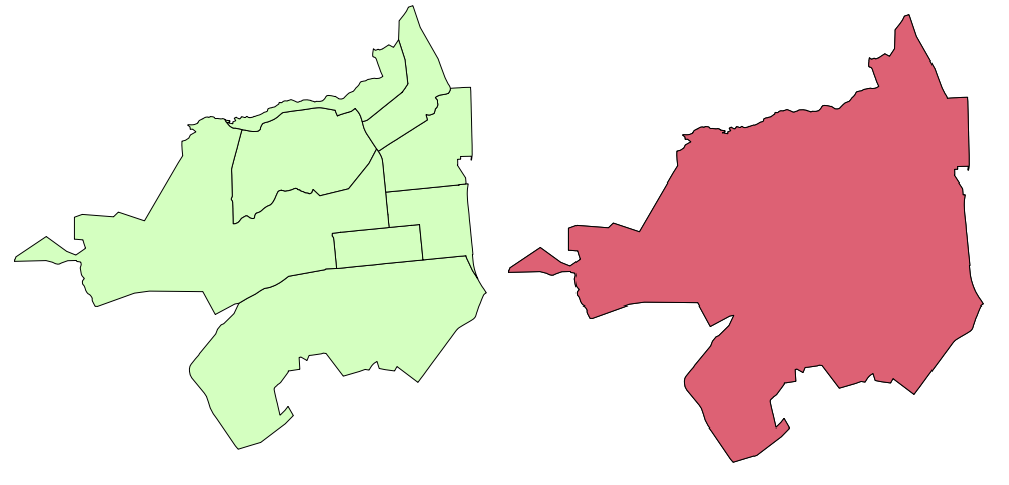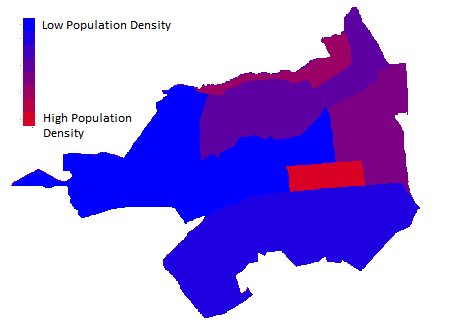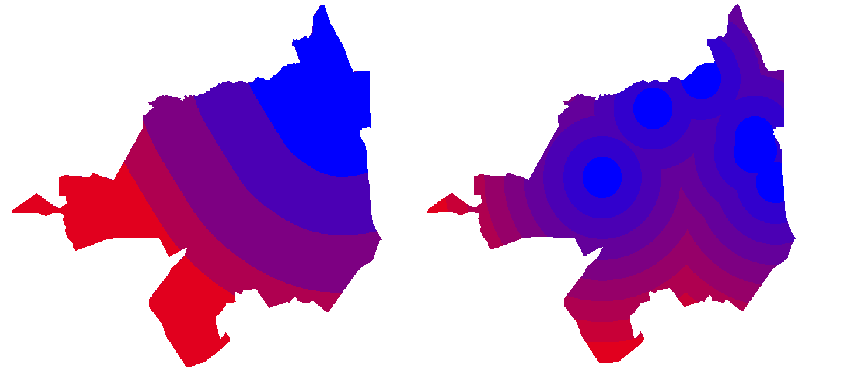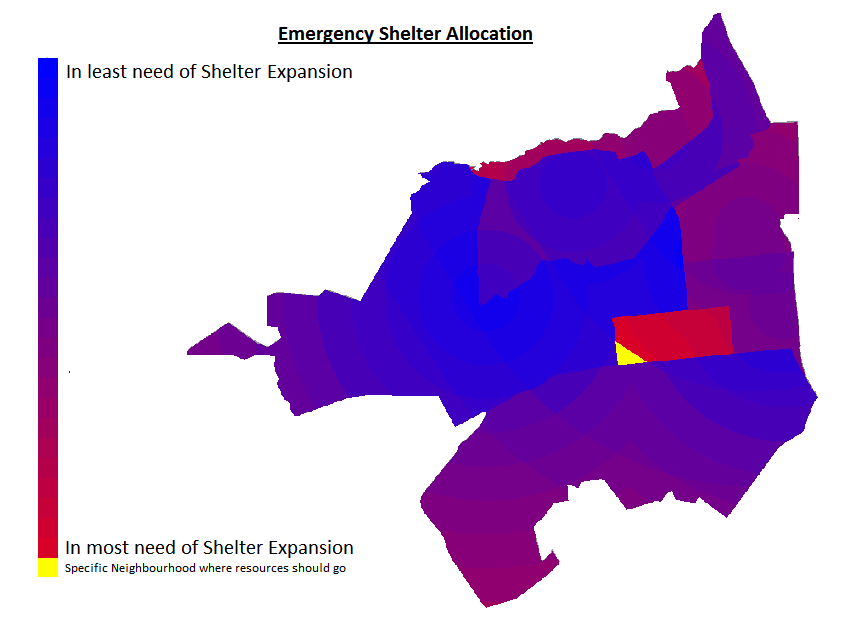Emergency Shelter Allocation Evaluation
Contents
Introduction
 FACT: Hawaii is the State most at risk of Tsunami conditions, Getting about one per year, a highly damaging one every 7 years. The biggest tsunami that occurred in Hawaii happened in 1946 when the coast of Hilo was hit with 30 ft waves at 500 mph, 170 fatalities. Click here for more facts of Tsunami Danger.
FACT: Hawaii is the State most at risk of Tsunami conditions, Getting about one per year, a highly damaging one every 7 years. The biggest tsunami that occurred in Hawaii happened in 1946 when the coast of Hilo was hit with 30 ft waves at 500 mph, 170 fatalities. Click here for more facts of Tsunami Danger.
This project was a spatial decision problem of allocating emergency shelter funding to the most vulnerable neighbourhood within the State of Hawaii. Spatial multi-criteria decision analysis can be defined as the “…optimization of one or several space related evaluation criteria” (Chakhar and Mousseau, 2008), and that is exactly what the objective of this project was. Although the application of multi-criteria spatial evaluation that was chosen for this project was emergency preparedness resource allocation, it is important to understand the vastness of applications this spatial decision process has. This method of spatially analyzing multi-criteria situations has experienced successful applications since the early 1990’s (Chakhar and Mousseau, 2008), and include ecology management, transportation, regional planning, waste management, agriculture, forestry, tourism management, etcetera (Malczewski, 2006).
Multi-criteria spatial analysis usually is a situation of compromise between conflicting parties involved where the options act as tools of mediation, if it be environmental activists against a private resource extraction firm and so on. In this particular scenario, the conflict was not a part of the initial reason for an allocation solution, but to understand spatially what locations displayed the most vulnerability in the event of a Tsunami, and the funding available would be rationed accordingly. The study area of Hawaii hold interesting laws within their statutes that diffuse a lot of tension in regards to what is considered an emergency shelter. The government puts financial resources towards individuals who privately own buildings, if it is their house, or hotel, and this building is then brought up to a standardized building code efficient enough for an emergency event, and then listed as a public location in the event of such emergency (Pacific Disaster Center, 2012). This removes the public upsets regarding the security of public parks being replaced as emergency shelters as the population increases. Therefore the application of this project is relatively objective in terms of political heist and conflict.
This tutorial will demonstrate how this type of evaluation can be carried out using only Free and Open-Source Software(FOSS), particularly using the Quantum GIS (2.18.10) desktop GIS. As opposed to early versions of QGIS and this tutorial, a GRASS plugin is no longer needed as the newest version of QGIS already includes everything needed.
Particularly, the scenario that outlines what the objectives are for this tutorial involve the expansion of Emergency Shelters in Hawaii pertaining to the emergency of a Tsunami event. The funding for this expansion has specific criteria which is as follows:
- Funds must be concentrated to the area of highest risk to large waves within the State.
- Shelter Location must be far away from Evacuation Land.
- Shelter Location must be in area of highest population density.
- Shelter Location must be far away from existing Shelters.
This tutorial is directed towards someone who has a minimal or basic understanding of GIS. The processes outlined throughout this tutorial may also be applicable in understanding gaps of public safety as a community evolves, or something as simple as determining the best location for a business expansion. The variety of applications are extremely widespread.
Data Collection
For this specific scenario, it was necessary to collect a variety of shapefiles (vector data) that are freely available online. There is a variety of online databases that have appropriate files with access to download freely. Sources of data very much depend on your geographical location and the government availability of free files.In this particular case the data was gathered from a catalog provided by the Hawaii State Government and U.S Census Bureau. Table 1. provides a specific breakdown of where each file was found and the adequacy of it.
To retrieve shapefiles from Hawaii State Office of Planning, click on "GIS LINKS" and click on "Hawaii Open Data Portal" and search for the appropriate shapefile name needed.
| Shapefile Name | Format | Data Source | Description |
|---|---|---|---|
| Tsunami Evacuation Zones | Vector Polygon - Preliminary Analysis/Final Anaysis File | Hawaii State Office of Planning | High risk area to Tsunami impact. |
| Tsunami Wave Heights | Vector Point - Preliminary Analysis File | Hawaii State Office of Planning | Locations of large wave events along the coast, attributes include year by year breakdown of events. |
| Emergency Shelters | Vector Points | Hawaii State Office of Planning | Locations of Shelters, and individual capacity. |
| Census Tracts | Vector Polygon | Hawaii State Office of Planning | Total Population by tract, 2015. |
Setup
As mentioned within the introduction Quantum GIS(QGIS) version 2.18.10 is used to carry out this analysis. The following three sections will provide specific instructions as to how to download the necessary software and the appropriate set up to begin your project.
Install QGIS
If you don't already have the appropriate software downloaded to your computer, Click here to do so according to your running platform of your computer. Along with this download is the GRASS package that will allow you to add the GRASS plugin once you are in QGIS, requiring no additional download for this plugin.
Setup Workspace
Before starting anything further it is important to save your workspace.
- Click File tab ⇒ Click 'Save Project As' ⇒ save it alongside your other data.
- Continue to save workspace ongoing.
Then you can load your shapefiles into your workspace (Only Vectors to work with):
- Click the 'Add Vectors' button at the top left of the screen.
- Leave the 'Source Type' as File, and Encoding as System (default).
- Browse to location you saved your data and click a file and choose only the shapefiles. Your data will now be visible and the layers are a part of the table of contents on the left hand side of the window.
Preliminary Analysis
Initially it is necessary in this particular instance to perform a preliminary analysis. This will narrow down exactly what region of Hawaii is most vulnerable to Tsunami activity.
Deciding Area of Interest
The shapefiles used for this process were Tsunami wave event recording points and Evacuation Land polygons, outlined in Table.1. The area of interest was determined based on the quantitative attributes within each file. The following section will outline the process of creating an output that would assist in deciding what the most vulnerable area is, resulting in our specific area of interest.
Quantitative Map Output
Exploring the attributes is majorly helpful in deciding how to manage the data available. That is the first step I took. To view the attributes please follow these outlined steps:
- After adding your data to the table of contents, you will now be able to view all necessary layers.
- Right click the title of your layer (file name) which will open a menu ⇒ click 'Open Attribute Table'
- Here you will be able to view the columns of data.
I chose the Wave Heights layer to explore first. It had a column for each significant year of high waves, showing the highest recording of that year for each storm location. I then thought it would be appropriate to quantify these values spatially. To do so it was necessary to edit the attribute table, and add an additional column to calculate the total significant recordings. The following steps outline how I processed this information:
- Within the Attribute table window Click the 'Toggle Editing Mode' button ⇒ Click 'New Field' button
- Type in an appropriate name, and keep the Type as Whole Number ⇒ click OK.
- Click the 'Open Field Calculator' button ⇒ Make sure X is in box beside update existing field.
- Select Field to edit in drop down menu ⇒ selecting field just created. NOTE: There is an option to the left of the calculator to add field at the same time as calculating data, but I have broken this down into separate steps.
- Create an expression. The expression used here is very simple. I selected fields that had wave height information in them and added them together to create a total.

The resulting column looked like this:
- Click the 'Save Edits' button within the Attribute table window.
- Toggle off the 'Toggle Editing Mode' button ⇒ Close the attribute table window.
Secondly, I explored the Evacuation Land shapefile attributes. It's attributes were much more simple and already had a column signifying the AREA of each parcel of Evacuation Land. The parcel with the largest area was determined as most significant. This brings us to the cartographic symbology process. This is relatively easy, the following outlining the specific steps.
Symbolizing the Evacuation Land layer:
- Right click the layer name ⇒ Click 'Properties'
- Click the 'Style' tab ⇒ where it says single symbol click the drop down menu and select 'Graduated'.
- Select column to symbolize, in this case it was AREA ⇒ choose a colour ramp, decide the number of classes appropriate (in this case 6), and type of classification (in this case equal interval).
- Click 'Classify' at the bottom left of the window ⇒ then 'Apply' and 'OK'
You should now see the layer symbolized, and the legend can be seen by expanding the layer in the table of contents.
Symbolizing the Tsunami Wave Height Event layer:
- Right click the layer name ⇒ Click 'Properties'
- Click the 'Style' tab ⇒ where it says single symbol click the drop down menu and select 'Graduated'.
- Select column to symbolize, in this case it was WaveHeightTotal ⇒ choose a colour ramp, decide the number of classes appropriate (in this case 4), and type of classification (in this case equal interval).
- Click 'Classify' at the bottom left of the window ⇒ then 'Apply' and 'OK'
You should now see the layer symbolized, and the legend can be seen by expanding the layer in the table of contents.
Please see Figure 1 for summary map of most vulnerable area of Hawaii to the affects of a Tsunami.
Figure 1: (Above)Map shows the most vulnerable coastline area in Hawaii. Assume the NW side of the area to be ocean, and the SE side to be the inland.
This map quantitatively shows the information edited earlier. However, the polygons of the Evacuation Land is somewhat determined based on the population of that area (county/metropolitan area) rather than based on a terrain analysis, which could be considered an inconsistency and tough to base an accurate decision off of it independently. This brings in the importance of the Wave Height Total layer. It shows a remarkable number of incidents, all of which are the highest or second highest events in the state. Therefore, this area of Hilo City was determined as the area of interest for this project, despite some inconsistencies within the data. For the sake of this being a precautionary preliminary step this is a pretty good method of narrowing down a area of interest (AOI). Further analysis could be done by finding the historical records of the state, and statistically analyzing the information and create your own vector layer accordingly.
Data Processing
This section involves preliminary editing that narrows the data collected for the entire state down to just the AOI of Hilo. These stages will bring simplicity to the later stages of this project, and have all the files in the exact formats necessary to carry out this analysis.
Please note: altering the projection was not necessary in this project, and therefore not included in this tutorial. If this is the situation for your data please click here for methods of changing projection.
Clipping to AOI
Clipping is the process of creating a new vector file that include only the data required for the very specific area of interest. The input features are extracted and made into an individual vector file. In this case Emergency Shelters, Evacuation Land and the Census Tracts data is needed to be clipped (Wave Heights not useful beyond preliminary analysis). The following will outline the steps necessary to complete a Clip.
- Select the 'Select by single feature' icon,it can be found by going to the 'view' tab at the top and go down to 'select' and click on 'select feature' and this will now allow your mouse to select the features that are included in your study area. You can also use 'Select by Rectangle', but often the irregularity of study areas causes for sections to be selected that aren't necessarily applicable. You can also select through the attribute table, there are many ways about going to do this.
- Once you have all the data within AOI selected ⇒ Click 'Vector' tab at the top of the QGIS window ⇒ Click 'Geoprocessing Tools' ⇒ Click 'Clip'
- Choose your input vector layer to be clipped ⇒
- Use Census Tracts Data to be the clip layer (extends beyond all other necessary data in this case) ⇒
- Name an output name in the appropriate directory by clicking 'browse' ⇒ Click 'OK'
- Repeat the last three steps again for all vectors that need to be clipped, in this case this was done for Emergency Shelters (output named ES.shp) and Evacuation Land (output named EL.shp)
Please see Figure 2 for clipped AOI.
Figure 2: (Above) Summary map of layers clipped to AOI.
Dissolve AOI
This stage of data processing is necessary because after using the proximity tool within the methods section, the created output from this step will be used as a mask to clip that raster file to this extent. Dissolving simply means taking a vector file with multiparts (in this case multiple polygons) and making it one uniform polygon. In this project, a dissolve was performed on the Census Tract polygon vector file (please see result in Figure 3). The following steps outlines how this was done.
- Once you have all the data within AOI selected ⇒ Click 'Vector' tab at the top of the QGIS window ⇒ Click 'Geoprocessing Tools' ⇒ Click 'Dissolve'
- Input Census Tracts layer ⇒ dissolve the AREA field ⇒ name an output file and place it in appropriate directory ⇒ Click 'OK'
Figure 3: (Above) Census Tract boundary before and after of the dissolve tool.
Attribute table editing
To turn on the capability of editing your attributes please follow these steps:
- Right click the title of your layer (file name)in the table of contents which will open a menu ⇒ click 'Open Attribute Table' ⇒ Here you will be able to view the columns of data.
- Within the Attribute table window Click the 'Toggle Editing Mode' button
Calculating Population Density
Population density was calculated for the Census Tracts layer. The census tracts are not even in size, and so therefore it is not mathematically correct to symbolize only the total population but the population based on the area of the polygon to create normalization. I had to refer to the metadata that was downloaded in conjunction with the shapefile to figure out what column represented the total population, as a large number of columns of information are available in this layer's attributes. In this case total population was represented by column 'tractce'. The other column of information that is useful throughout this calculation is the Area variable column, which is very common to have included, although it may also be necessary to calculate initially (calculate geometry). The following steps outline how the population density was calculated (assuming you have toggled the editor on):
- Click 'Field Calculator' button ⇒ Leave X in box beside 'Create a new field' ⇒ Type a Field name (in this case POPdensity) ⇒ Leave output field type and field width as default.
- Create your expression. In this case it was "tractce" / "st_areasha" ⇒ Click 'OK'
- Toggle off the editing icon, once your calculations are complete.
You will now have a new column and it will be filled with the appropriate ratio calculated.
GRASS Vector to GRASS Raster with Attributes
This step was carried out on all three variables. In this process you will see the conversion of the Census Tract Population Density layer. The reason for converting with attributes is because it allows for keeping the Population density variable created, and have it spatially quantified. NOTE: The emergency shelter and evacuation land do not have to have associated attribute variables with them. The following outlines how this was done:
- At the top of the QGIS main menu click the 'Raster' button and then choose 'Conversion' and click 'Rasterize'.
- Select input vector layer you wish to rasterize (in this case the Census Tracts layer) in the drop down menu
- In the Attribute Field, select the Population Density column that was created ⇒ Give the Output Raster Map a name ⇒ Click 'OK'
Again this was carried out for all three variables used in this part of the analysis. This concludes the data processing necessary for this project. Please see Figure 4 for the Population Density output map.
Figure 4: (Above) Population Density map after the conversion process.
Methods
This section will enlighten you as to the process I took in creating a decision analysis. The creation of a suitability map is necessary to come to some sort of decision as to where the allocation of the funds is most appropriate. The process will be outlined step by step as done so thus far. While going through these processes with your own data it is important to keep the logic of what is ideal in your head, and what acceptable thresholds are in your head.
This projects interest is to find areas that are in the most need of emergency shelter expansion. Basically trying to locate the are of an emergency preparedness deficiency in terms of emergency shelters. Ultimate suitability for this location consists of the area with a high population density, far away from existing emergency shelters as possible, and far away from the evacuation land.
To explain this further, it is ideal to declare the highest population density as the most necessary requirement for this criteria because shelter capacity is not going to go as far, and more shelters will be necessary. It is ideal to be as far away from existing emergency shelters as possible as this will show the largest gap in coverage. Distance away from evacuation land is necessary because this is considered a high risk zone, and although that population will flood into the inland population's emergency shelters, this also causes for a distance away from this high risk zone.
As a reminder this analysis is using:
- Emergency Shelters - raster file
- Evacuation Land - raster file
- Census Tracts - raster file
Proximity Tool
The proximity tool is useful in understanding the distance between similar objects. It calculates the euclidean distance from one object within a vector file to the next. The output is a raster. This scenario called for the proximity tool to be run on emergency shelters and evacuation land GRASS rasters. The following outlines the steps that were taken:
- Click the 'Raster' tab ⇒ Click 'Analysis' and select 'Proximity' within that drop down menu.
- Select Input raster ⇒ choose an appropriate directory for the output file (with original data).
- Make sure X is in box beside 'Dist units' ⇒ from that drop down menu choose pixel.
- Make sure C is in box beside 'Load into canvas when finished' ⇒ Click 'OK'.
Please see Figure 5 for the resulting outputs from this tool.
Figure 5: (Above) Evacuation Land (left) and Emergency Shelters (right) is the resulting proximity rasters from using the proximity tool.
Please NOTE: Proximity only goes to the extent of the raster. A side step was taken here, adding false points (corners) into the vector file, and false polygons to change the extent it made a proximity of. This is different based on the geographic extent and shape of your files and may not be necessary. The false information was added in the attribute table, will not further explain as those types of tasks have already been outlined in this tutorial before this point.
Clipper Tool
The Clipper tool is useful because it clips a raster to a certain vector boundary (hence the reason for creating a dissolved layer). This was necessary for both of the proximity layers (emergency shelters and evacuation land). Please follow the steps outlined below.
- In the main window of QGIS click the 'Raster' tab ⇒ Click Extraction for drop down menu ⇒ Click 'Clipper' tool.
- Input the file to be clipped (proximity rasters)⇒ select file name and destination place as output.
- Use clipping mode 'Mask Layer' ⇒ Load mask layer which is the vector layer output from the dissolve process (can select from drop down menu if already in table of contents, otherwise you will have to press 'Select' button to find the directory where it was saved).
- Make sure an X is in box beside 'Load into canvas when finished'⇒ Click 'OK'
Please see Figure 6 for the outputs from this step, this tool clipping to the extent of the dissolve layer acting as a mask or 'cookie cutter'.
Figure 6: (Above) Evacuation Land (left) and Emergency Shelters (right) is the resulting clipped rasters from using the clipper tool.
Reclassify Rasters
This stage of the decision analysis is necessary to simplify the classification to be more manageable. Reclassification allows manipulation of the classes, and alter values specific the needs of the situation. The following section will break down the logic and processes of this.
Calculation Logic To Reclassification
When reclassifying rasters, it is important to think of the data as it originally was. In this instance we have data specifically classified pertaining to population density, and euclidean distances which are linearly classified data types.
The proximity rasters created were linearly classified from 0-255. The Emergency Shelter location raster was reclassified so that every 25 values there is an increased value assigned (250-255 grouped into last class). The following image allows you to see specifically the classification transition between the first and second class.
The Evacuation land raster was reclassified so that every 50 values there is an increased value assigned (250-255 grouped into last class). The following image allows you to see specifically the classification transition between the first and second class.
Lastly the Population Density raster was reclassified so that the difference in population remained true, just simplified. The following image is a summary as to what all values were reclassed to:
Creation of Text files
Text files were made with the logic explained in the above section, the format of these text files can be seen in the images in the above section. The creation of text files is necessary as an input file when using the Reclassify tool. Please see the following stage to understand how the created texts files were used.
Executing Reclassify Tool
This section provides steps as to how to run the reclass tool within the GRASS plugin. Please see the following steps:
- In the main QGIS window click the 'Processing' and choose 'Toolbox'from there you will search for the 'Reclassify' tool.
- Click the Modules list ⇒ in the Filter box type r.reclass ⇒ click on the tool that is listed.
- Input the raster map to be reclassified
- Search for the File Containing Reclass Rules parameter by Browsing to the location of your saved reclass rules text file
- Specify an Output Raster Map name ⇒ Click 'Run' ⇒ Click 'View Output'
Repeat this process to obtain all raster reclassification rasters, appearing in your table of contents once finished.
Suitability Calculation
To create a combined raster that displays all variables weight (reclassification value) over the City of Hilo, all the rasters must be added together using the Raster Map Calculator. Figure 7 shows the resulting output of this tool. To produce such output please follow the following steps:
- In the main QGIS window click the 'Processing' and choose 'Toolbox' and search for 'mapcalculator'
- Click the Modules list ⇒ in the Filter box type r.mapcalculator ⇒ click on the tool that is listed.
- Insert A as first raster (Population density) ⇒ Insert B as second raster (Emergency Shelters) ⇒ Insert C as third raster, and so on for how ever many variables in your scenario.
- Enter Formula A+B+C ⇒ Set a name for output raster map.
- Click 'Run' ⇒ Click 'View Output
Figure 7: (Above) The Raster Calculator resulting output, combining all three variable rasters.
Conclusion
Through this tutorial of the outlined methodology, it has been determined the neighbourhood where there is the largest deficiency of emergency preparedness resources. Please see Figure 8 for the end result of this process, highlighting in red the specific neighbourhood.
Figure 8: (Above) The final map highlighting what neighbourhood is in most need of expanded emergency preparedness resources, such as Emergency Shelters.
Multi-critera decision analysis is difficult when using FOSS such as QGIS and GRASS, as variables serve as factors or constraints and appropriate thresholds need to be decided as to what is acceptable or necessary in a particular instance. This project only required instances where the extreme values were effective enough, such as the highest population density, or the farthest distance away from the emergency shelters, etcetra. which majorly reduced the complexity. To manage these thresholds, this manipulation could be done within the reclassification stage of your project, assigning values based on appropriate literature.
This tutorial provided an adequate framework in making a decision with a variety of variables to consider. However, it is recognized that robustness testing could be applied for further satisfaction in concluding the resulting optimal area is indeed optimal. This error analysis would occur within the reclassifying stage, altering the values assigned by hierarchically determining what deserves the most consideration would be appropriate. Multiple potential allocation options would be favourable when in a situation of deliberation between conflicting interests to successfully resolve the issue and make a decision.
Goodluck on your project.
References
- Images:
- Data:
U.S Census Bureau, Geography Division (2009) "2009 TIGER/Line Shapefiles for: Hawaii"
Hawaii State Government (2012) "Hawaii State GIS Program"
Academic papers used:









